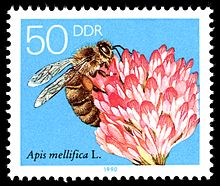A first field study was conducted to investigate the possible adverse effects that seeds dressed with neonicotinoid insecticides pose to honeybees during sowing. It was observed that in the exposure hives bee mortality increased on the day of sowing and that the number of foraging bees decreased the days after the sowing. The corn sowing posed a significant threat to honeybees, with thiamethoxam being the most probable toxic agent. A theoretical contact exposure was calculated for a bee when flying over the sown fields, revealing a dose of 9.2 ng bee−1 close to the contact LD50 of thiamethoxam.
Source: Paolo Tremolada, Marta Mazzoleni, Francesco Saliu, Mario Colombo and Marco Vighi
Field Trial for Evaluating the Effects on Honeybees of Corn Sown Using Cruiser® and Celest xl® Treated Seeds
Bulletin of Environmental Contamination and Toxicology
Volume 85, Number 3, 229-234, DOI: 10.1007/s00128-010-0066-1
http://www.springerlink.com/content/y138723038272648/

- Log in to post comments
